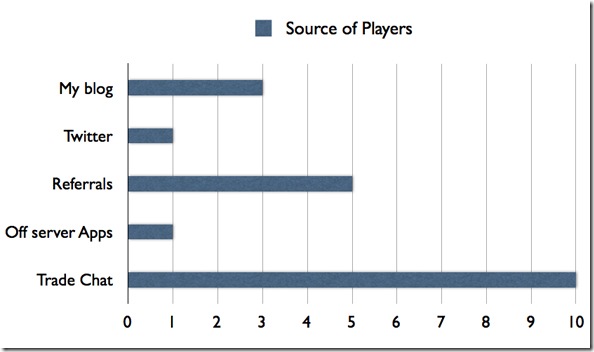
I don’t get a lot of email. But the ones I do get are often insightful questions. Heh, sometimes I have to respond to the reader and tell them that an email response wouldn’t do their email justice. The next best thing is to convert their question and topic into a blog post so I can really attack it from all angles.
From Ephii:
I see that you’re posting in trade to advertise/recruit. Our guild is currently recruiting but our members have always felt that spamming trade carries a social stigma of being "one of those crappy guilds." We were the most progressed Alliance guild in TBC until some of our core members transferred off. Our reputation is sterling as the mature guild with players who don’t run their mouths. However, we’re having problems getting new recruits by posting on the realm forums alone (for server recruits). What is your take on posting in trade?
Ephii runs a really cool Shadow Priest blog, interestingly enough. Pay attention to the Healing Macros post.
Back to the question at hand. I can understand why players don’t like to advertise in trade. Trade chat has traditionally been viewed as a place where scoundrels, heathens, morons, and bad players congregate.
So why would I want to advertise my guild there?
Because, like it or not, it is the largest channel in terms of population. Just because you have scoundrels, heathens, morons and bad players running their mouths off in trade chat doesn’t mean that you have scoundrels, heathens, morons and bad players reading it all the time.
I used to think about trade chat the same way. I wouldn’t want any guild I was a part of to advertise there because of the perception that those bad players bring. Why would I want to play or raid alongside these trade chat pollutants, right? Only crappy and unskilled guilds recruit from trade chat. Real good players are the ones that transfer to you off server and come to you directly. With that in mind, I shouldn’t advertise in trade chat.
Why is this wrong?
You have to start somewhere. Unless you’re a top 20 guild, you’re never going to be able to attract top level talent. The only way to attract talent is to prove that you have tenacity to get the job done with whatever members you have at your disposal. At this point, for most guilds, their immediate goal is to attract players. Skilled players come later. Weak players weed themselves out as time goes on.
As GM, my immediate goal is to get into the 25s as soon as possible. I wanted to develop the image and perception that Conquest would be a successful guild. In order to do that, I have to have at least 25 raiders. Without it, my goals are as good as dead in the water. I don’t have the reputation yet to be able to convince or draw 25 players without utilizing trade chat.
Lesson of exposure
One important concept I was taught in marketing is the concept of exposure. If you don’t expose yourself, people aren’t going to know you. If they don’t know you, they’re not going to join you.
Let’s put it this way.
I’m an electronics chain looking to unload some Blu-ray Players. Specifically, I got these kick ass Samsung BD-P1500 Blu-ray Player‘s lying around. 
Let’s forget the fact that it’s 1080p, HDMI, Dolby Digital, and comes at a low price of only $199. Because it’s not important.
(I can hear the epic sighs and see the head shaking but I’m trying to prove a point here!)
You wouldn’t have known that if I hadn’t told you. If I was working in marketing and I wanted to sell as many of these as I could, I have to make people aware that I’m selling these. Why do you think advertising is a multi-billion dollar industry? Companies employ television ads, magazine and newspaper ads, billboards and our most hated enemy are banner ads.
Hell, people call you at 7 PM when you’re having dinner to ask you to buy something. Those guys, I want to shoot.
Everyone is competing for your attention.
We’ve grown accustomed to filtering them out. But if a company can attract your attention for even a few seconds, they’ll have succeeded because they want you to think about them. The next time you get the urge to to buy a product or pursue a service, they’re banking on you to remember it.
Back to trade chat
So how does this apply to WoW guilds and recruiting? It’s the same general principle. People aren’t going to buy stuff if they don’t know you have them. Players won’t apply for your guild if they don’t know you exist. For guilds that are just starting out, trade chat is the biggest source of potential recruits because in my experience there are three types of players:
- Players that aren’t looking for a raiding guild
- Players that are looking for a raiding guild, but don’t know it yet because they’re waiting for the right opportunity
- Players that are looking for a guild
Numbers 2 and 3 are the most important. Offering EST friendly hours was one of the best moves I was able to make because I didn’t alienate players on the other side of the continent. I advertised this in trade and received a number of applicants this way because they weren’t able to handle raiding up until 1 AM or 2 AM anymore. The only reason they stayed in their current guild was because they had little choice.
But by exposing my guild, my days, my times, my goals, and wants, I gave them another way out. Raiders looking to join raiding guilds generally have little to say in trade chat. You’ll be amazed at how many people you can pick up from there.
Realm and guild recruitment forums are nice. But only a small fraction of players check those. In my experience, those tend to be the 3rd category of players.
Although you may hate it, trade chat’s going to be the biggest source of recruits for you. Take advantage of it. Otherwise, you’re going to be waiting for a long time.
For my purposes, I view trade chat as a necessary tool. I don’t exactly have people knocking on my door and I need to spotlight my guild as much as possible. This means plugging it on Twitter, using my blog, advertising in Trade chat, using the realm forums, the guild recruitment forums, my Plusheal forums and so forth.
Where did they come from?
Since my guild is still relatively lean, I still remember where (most of) my players come from:

When I mean off server, I don’t mean transfer. These are players that were a result of advertising on guild recruitment forums. I probably had around 7ish server transfers (if you include the blog and twitter). Referrals are players that a guild member knows. A Paladin applies, gets in, refers a Rogue and a Shaman and those guys subsequently get in as well. They may or may not have been exposed to trade chat. Had I not advertised in trade chat, the original Paladin would not have known about Conquest or advised his friends about it.
Don’t judge the quality of every player in trade chat by what’s said. Most of us generally keep our mouths shut. Just because we don’t say anything doesn’t mean we aren’t reading.



